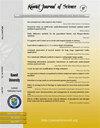Diversity and variability of biomolecules under material and environmental factors in Cymbopogon citratus L., traditional uses, antimicrobial properties, and recommendations for future research
IF 1.1
4区 综合性期刊
Q3 MULTIDISCIPLINARY SCIENCES
引用次数: 0
Abstract
Studies conducted on Cymbopogon citratus L., or lemon grass, have identified several active compounds that promote a variety of biological functions. However, existing data demonstrates a significant variability in the quality and quantity of chemicals that impact their biological properties and medicinal uses of the plant. Therefore, this study summarizes existing data on the diversity and variability of bioactive compounds in extracts of Cymbopogon citratus, their traditional uses, and their antimicrobial properties. To achieve these goals, we used an electronic literature review using targeted keywords related to the study topics and research gathered from papers published between 1980 and 2024. Recorded data demonstrated a wide range of chemical compounds, including polyphenols, flavonoids, terpenes, etc. These chemicals were variable between extracts and essential oils depending on plant materials, growing conditions, and extraction methods. Due to their richness in chemicals, different parts and extracts of Cymbopogon citratus are used in traditional medicine to manage anticancer, antimicrobial, antidiarrheal, antiamoebic, antifilarial, antiseptic, antitussive, analgesic, anesthetic, and anti-inflammatory diseases. In terms of antimicrobial activities, extracts and essential oils, as well as their components, showed a significant inhibitory effect against bacteria, fungi, and viral agents. These inhibitory effects are related to the capacity of bioactive molecules to impact the cells and intracellular components of treated microorganisms. To confirm these early findings, more in vitro and in vivo research on the anticancer and antioxidant mechanisms revealed by lemongrass components is necessary. Equally, in silico studies are needed to clarify the action mechanism of chemical compounds contained in the extracts and essential oils of lemongrass.
材料和环境因素下香茅生物分子的多样性和变异性、传统用途、抗菌特性及未来研究建议
对Cymbopogon citratus L.或柠檬草进行的研究已经鉴定出几种促进多种生物功能的活性化合物。然而,现有数据表明,影响植物生物特性和药用的化学品在质量和数量上存在显著差异。因此,本研究对香茅提取物中生物活性成分的多样性和变异性、传统用途和抗菌特性进行了综述。为了实现这些目标,我们使用了电子文献综述,使用了与研究主题相关的目标关键词,并收集了1980年至2024年间发表的论文。记录的数据显示了广泛的化学成分,包括多酚、类黄酮、萜烯等。这些化学物质在提取物和精油之间是可变的,这取决于植物材料、生长条件和提取方法。由于其丰富的化学成分,香橼的不同部分和提取物在传统医学中被用于治疗抗癌、抗菌、止泻、抗阿米巴、抗丝虫病、抗菌、止咳、镇痛、麻醉和抗炎疾病。在抗菌活性方面,提取物和精油及其成分对细菌、真菌和病毒具有显著的抑制作用。这些抑制作用与生物活性分子影响被处理微生物的细胞和细胞内成分的能力有关。为了证实这些早期发现,有必要对柠檬草成分所揭示的抗癌和抗氧化机制进行更多的体外和体内研究。同样,需要进行计算机研究,以阐明柠檬草提取物和精油中所含化合物的作用机制。
本文章由计算机程序翻译,如有差异,请以英文原文为准。
求助全文
约1分钟内获得全文
求助全文
来源期刊

Kuwait Journal of Science
MULTIDISCIPLINARY SCIENCES-
CiteScore
1.60
自引率
28.60%
发文量
132
期刊介绍:
Kuwait Journal of Science (KJS) is indexed and abstracted by major publishing houses such as Chemical Abstract, Science Citation Index, Current contents, Mathematics Abstract, Micribiological Abstracts etc. KJS publishes peer-review articles in various fields of Science including Mathematics, Computer Science, Physics, Statistics, Biology, Chemistry and Earth & Environmental Sciences. In addition, it also aims to bring the results of scientific research carried out under a variety of intellectual traditions and organizations to the attention of specialized scholarly readership. As such, the publisher expects the submission of original manuscripts which contain analysis and solutions about important theoretical, empirical and normative issues.
 求助内容:
求助内容: 应助结果提醒方式:
应助结果提醒方式:


